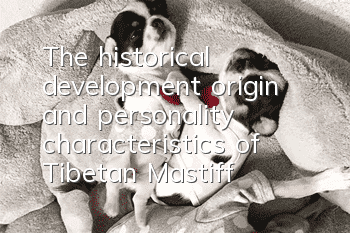The historical development, origin and personality characteristics of Tibetan Mastiff

Everyone knows that China has a unique ferocious dog breed, the Tibetan Mastiff. Its tall and ferocious appearance is also recognized as the oldest rare dog breed in the world. In ancient stories and legends, the Tibetan Mastiff has also been mythical. Many people keep Tibetan Mastiffs as pets, but few people understand the historical development and character of the Tibetan Mastiff. In addition to the history and fierce and fierce character listed above, what else does the Tibetan Mastiff have?
Tibetan Mastiff
1. History of Tibetan Mastiff
The Tibetan Mastiff has a history of thousands of years. As the oldest dog breed, it is recorded in the earliest historical book of China, "Shang Shu". It can be seen that this dog has been used as a guard dog as early as the Spring and Autumn Period. According to Chinese historical records, the nomadic people (Qiang people) at that time domesticated the wild dogs that followed the herdsmen to deal with attacks and threats from other ferocious beasts. They guard tents, protect cattle and sheep, and become loyal partners of herdsmen. This should be the prototype of the earliest Tibetan Mastiff.
In the extremely harsh living environment of the Qinghai-Tibet Plateau, Tibetan Mastiffs have also undergone the natural selection of "natural selection". In order to leave a stronger breed, the herdsmen selected some individuals who were strong, fierce, loyal, and good at herding animals to reproduce, thus maintaining the pure bloodline of the Tibetan Mastiff. Later, during the Qianlong period of the Qing Dynasty, Fu Qing, the Qing government's commander-in-chief in Tibet, who accompanied the Panchen Lama on his eastward march, brought a Tibetan Mastiff to Beijing. Both the government and the public were in awe of the majesty and majesty of the sacred dog. The Italian painter Castiglione followed the order of Qianlong and painted the last picture of "Ten Dogs", "Cang Ni", which shows this Tibetan mastiff.
However, whether in modern or modern times, it was Westerners who were the first to recognize its value and promote it. In the early 18th century, the British first began to cultivate Tibetan mastiffs and established pedigree files. In 1947, the first Tibetan Mastiff was brought to the United States. In 1973, the United States established the American Tibetan Mastiff Conservation Association in order to better protect, understand and breed this endangered dog breed, and began to protect, research and shape the Tibetan Mastiff.
2. Physical signs of Tibetan Mastiff
Marco Polo once described the Tibetan Mastiff in detail in his travel notes. He described the Tibetan Mastiff as "as tall as a donkey, roaring like a lion, and extremely ferocious." He was the first Westerner to put the Tibetan Mastiff into words.
Tibetan Mastiffs vary in appearance due to different living areas. Usually the head and neck are held high, the expression is majestic, the proportions are appropriate, the muscles are well developed, as strong as a lion, the body is large, about 120 cm in length, the body hair is thick and thick, the outer coat is not too long, the undercoat is thick, and it likes cold and is afraid of heat. The best-looking Tibetan Mastiffs come from the Nagqu region of Tibet. The mane is thick, the chest is broad, the eyes are bright, subtle and deep. The Tibetan Mastiff, which originates from the Qinghai region, has almost no mane.Its hair is also shorter and its body is larger, but its character is not as fierce and calm as that of ordinary Tibetan Mastiffs.
3. Tibetan Mastiff’s character
A true Tibetan Mastiff has a kingly demeanor that is not angry but has no authority. The harsh living environment on the plateau not only creates the Tibetan Mastiff's strong willpower and contempt for everything, but also gives the Tibetan Mastiff the temperament of a king. Its lonely, cold and arrogant, mighty and brave, noble and elegant character, loyal and dedicated character and its ability to withstand hunger, cold and all hardships are also its most attractive features. Therefore, Tibetan Mastiffs usually protect territory, protect food, are good at attacking, are powerful and ferocious, and still have wild nature, which makes people intimidated and have strong hostility towards strangers, but they are extremely affectionate towards their owners.
- How long does it take for dogs to be dewormed before all the worms are killed?
- Signs of depression in dogs, come and see if your dog has it
- What should you do when faced with "fungi + mites + inflammation"?
- Select competition-grade Husky puppies based on bone proportions
- Illustration of the correct ways and precautions to greet your dog
- Dogs have dandruff and hair loss
- What to do if Teddy can’t digest dog food
- Will the ancient shepherd dog recognize its owner?
- Does Corgi recognize its owner?
- Can a dog recover after being hit by a car and unable to stand on its hind legs?



